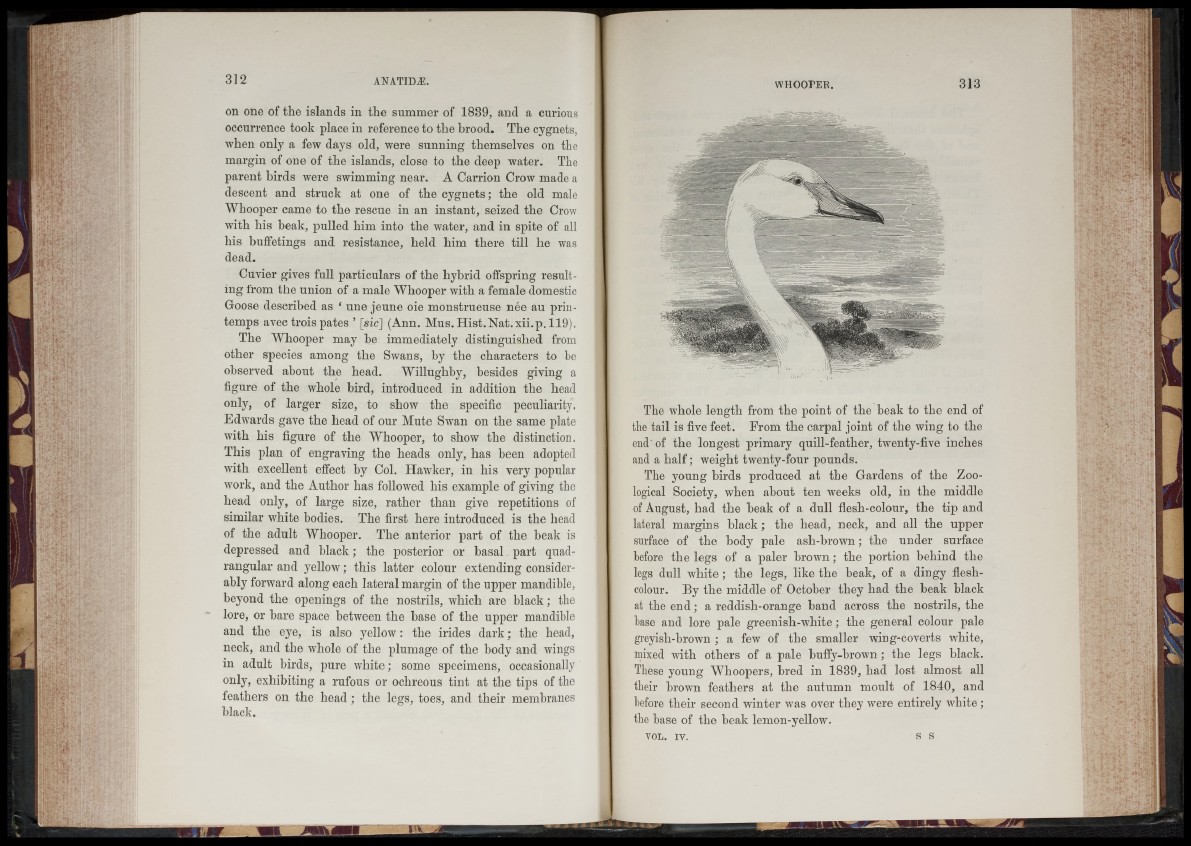
on one of the islands in the summer of 1839, and a curious
occurrence took place in reference to the brood. The cygnets,
when only a few days old, were sunning themselves on the
margin of one of the islands, close to the deep water. The
parent birds were swimming near. A Carrion Crow made a
descent and struck at one of the cygnets; the old male
Whooper came to the rescue in an instant, seized the Crow
with his beak, pulled him into the water, and in spite of all
his buffetings and resistance, held him there till he was
dead.
Cuvier gives full particulars of the hybrid offspring resulting
from the union of a male Whooper with a female domestic
Goose described as * une jeune oie monstrueuse née au printemps
avec trois pates ’ [sic] (Ann. Mus. Hist. Nat. xii.p. 119).
The Whooper may be immediately distinguished from
other species among the Swans, by the characters to be
observed about the head. Willughby, besides giving a
figure of the whole bird, introduced in addition the head
only, of larger size, to show the specific peculiarity.
Edwards gave the head of our Mute Swan on the same plate
with his figure of the Whooper, to show the distinction.
This plan of engraving the heads only, has been adopted
with excellent effect by Col. Hawker, in his very popular
work, and the Author has followed his example of giving the
head only, of large size, rather than give repetitions of
similar white bodies. The first here introduced is the head
of the adult Whooper. The anterior part of the beak is
depressed and black ; the posterior or basal part quadrangular
and yellow ; this latter colour extending considerably
forward along each lateral margin of the upper mandible,
beyond the openings of the nostrils, which are black ; the
lore, or bare space between the base of the upper mandible
and the eye, is also yellow : the irides dark ; the head,
neck, and the whole of the plumage of the body and wings
in adult birds, pure white ; some specimens, occasionally
only, exhibiting a rufous or oclireous tint at the tips of the
feathers on the head ; the legs, toes, and their membranes
black.
The whole length from the point of the beak to the end of
the tail is five feet. From the carpal joint of the wing to the
end of the longest primary quill-feather, twenty-five inches
and a half; weight twenty-four pounds.
The young birds produced at the Gardens of the Zoological
Society, when about ten weeks old, in the middle
of August, had the beak of a dull flesh-colour, the tip and
lateral margins black; tbe head, neck, and all the upper
surface of the body pale ash-brown; the under surface
before the legs of a paler brown ; the portion behind the
legs dull white ; the legs, like the beak, of a dingy flesh-
colour. By the middle of October they had the beak black
at the end; a reddish-orange band across the nostrils, the
base and lore pale greenish-white ; the general colour pale
greyish-brown ; a few of the smaller wing-coverts white,
mixed with others of a pale buffy-brown ; the legs black.
These young Whoopers, bred in 1889, had lost almost all
their brown feathers at the autumn moult of 1840, and
before their second winter was over they were entirely white ;
the base of the beak lemon-yellow.
VOL. IV. s s